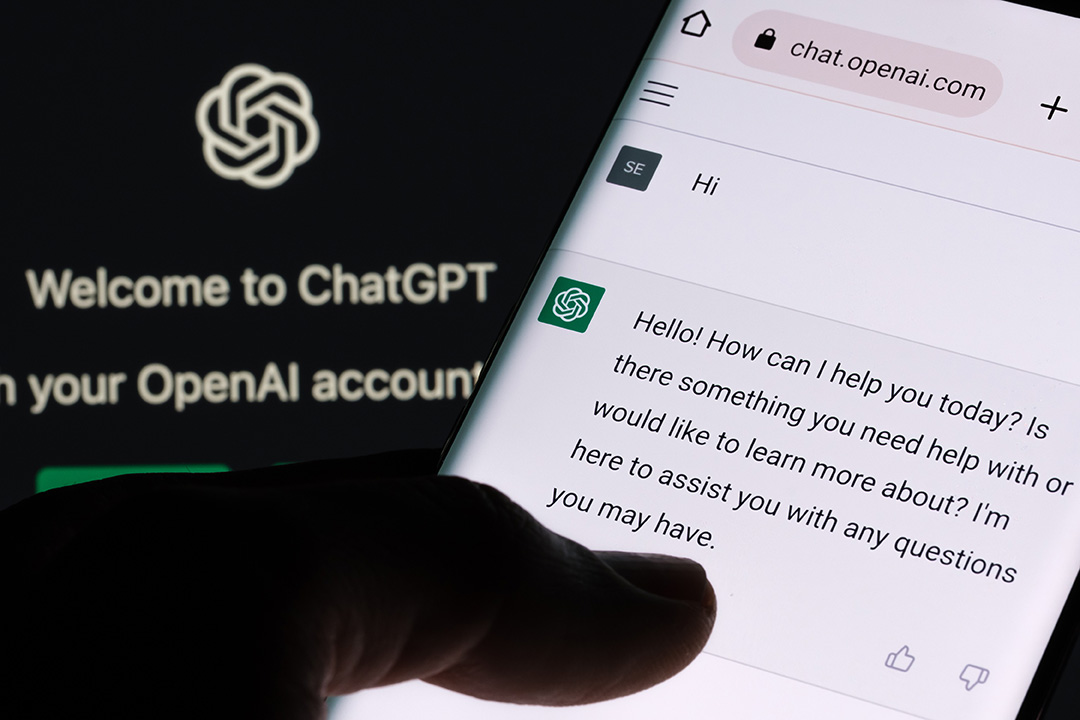Trends / 16-10-2023
But what does AI currently really bring to the everyday work of a medium-sized real estate company? Where is it helpful, where possibly useless? A reality check.

The AI Hype: The Business World is Excited
The software behind the most popular generative AI application, ChatGPT, has been “fed” an incredible amount of data, can now read the internet and make sense of the information. However, the last data input was made in 2021 – a not insignificant limitation. ChatGPT inventor Sam Altman, in view of the euphoria surrounding his platform one of the world’s most important minds in the field: “We are experiencing exponential growth. It’s a pace we humans can barely grasp.” Some AI consultancies predict that by 2030, 99% of all content on the Internet will already be created by AI.
After all, 70% of Dax corporations say AI is changing their business model, according to Handelsblatt. It is almost astonishing that 30% (still) deny this. The big question here for many: “How will the job world change for me?” But also, “Where can AI support us and make work massively easier?” So what does this mean from the perspective of a medium-sized (real estate) company like MÄHREN AG? This field report is therefore about the opportunities that arise from the use of AI for a medium-sized real estate company and the corresponding departments. What contribution can AI make to more productivity, creativity and ultimately added value and growth – and where not yet?
AI in use at MÄHREN AG
Data security
Compliance and data security is one of our fundamental requirements in everyday business. We pay close attention to what information we enter into non-company applications and networks – and have therefore been doing without quite a few helpful tools for several years now. This also applies to all AI applications. Many corporations, such as Bosch, have solved this problem with in-house AIs – a powerful solution to help companies learn how to handle them and find value for employees. But for a company of our size, this is unrealistic, at least for now. So when it comes to sensitive information, this is where the big benefit of AI fails.
AI in the reality check of the Marketing & Communications unit
The Marketing & Communications team has been working intensively on AI for months. We sit down regularly just on this topic and distribute AI test assignments along our ToDo’s: Website, Social Media, Performance Marketing, Internal Communications (Intranet), Branding, Creating Press Releases, Brochures, Presentations and Exposés, Graphics, Photos and Videos. First and foremost, we do this to try everything out and to find out what AI tools currently really offer.
AI is a highly live topic for us and highly relevant. Spoiler alert!: However, the real-world effects are there, but so far very manageable. For a professionally set up communications and marketing team, like the thousands that exist in other companies, the results in terms of creativity, quality or labor savings have so far been very limited – provided you have skilled people for the relevant tasks. However, for someone who has little communications/marketing expertise because he or she actually works in a different profession, AI could be helpful if, for example, texts, marketing concepts, postings or even exposés of houses have to be created.
There are already an incredible number of tools beyond ChatGPT. We’ve tried about 40 in our field to date: for image editing, lead generation, creation of videos, images, podcasts, music, texts and presentations; for research, digital marketing and social media. However, most of them (about 90%) are currently unusable – at least for our purposes. However, this can and will change in the future. Every day, new tools appear on the market or inferior applications become really good through updates. So you have to stay on the ball permanently and here you literally wish for a special service provider who brings you up to date in terms of which tools you can use for your field.
As a potential customer, we are also aware that many AI tools are not yet running smoothly: For example, we have been receiving more and more cold-call emails for a few months now, which clearly originate from an AI project. Instead of “MÄHREN AG”, “Moravia AG” is written to (English for the “Moravia” part of the country in the Czech Republic) and the acquisition text is very template-like and literally as if written by a machine. This is impersonal, professionally at the lowest level and immediately ends up in the trash. Such “mailings” are basically an impertinence – and do not outweigh the efficiency on the part of the sender at all.

What is the specific situation in Marketing & Communications with AI support?
In parallel to the social media postings we created in the team, we sent ChatGPT into the race. Result: Only fractions of the postings are usable, the vast majority is clumsy and openly recognizable as machine text. No post suggestion we ended up using, a few times we took a particular wording as a suggestion. Even with AI tools that offer “branded content,” that is, content that supposedly adapts its output to the company’s tone after several appropriate prompts, the content was significantly worse than that written in-house. We felt similarly about copy for all other communication channels.
Although we had dealt with “prompting” in a catchy way and had acquired some initial expert knowledge in this area, the textual results were quite sobering. Only little was usable. Why? Because our so-called corporate tonality, as in many other companies, is based on a “person-to-person” communication style.
This means always striking a contemporary tone, sensitively controlling the emotionality of the respective text, using the team’s many years of professional experience in how target groups need to be addressed, using intelligent wordplay, puns and topical references to build a connection with readers and, in the end, also entertaining our users in addition to serious B2B content.
Our conclusion: AI is currently nowhere near as good at this as experienced communications experts and copywriters.
Next spoiler: These AI tools are not relevant for us at the moment. Because in order to present our business model and company, we essentially have three photo segments: real buildings from our inventory, photos of our team with CEO Jakob Mähren at the helm, depicted in many work situations, and images that illustrate our general company content and topics. In other words, image content that cannot be derived from fantasy worlds and / or arbitrary sample photos. So we don’t have any of the really great applications such as Midjourney, all of which we’ve tried.
For illustrative images, we use a stock provider where you can get suitable images for three euros in just a few minutes. It doesn’t make sense to use the AI to find out in several prompts that you can currently get it much better (because it’s more realistic) and faster. The time required for the prompts and the refinement alone – converted into labor costs – would be disproportionately high.
And: The AI-generated images all still looked quite artificial and impersonal, which does not correspond to the visual language of our and many other companies.
On the subject of website coding: we are currently retreading our website. There are great AI effects here. Some of the relevant code that has to be written for this is now being taken over in part by the AI. According to our IT service provider, he now regularly draws on the support of AI tools and sees considerable added value here.
Another very helpful example: the creation of a model release contract. With the right prompt, ChatGPT was able to set up a legally compliant contract in seconds, which we need for the photos of our team members if we want to publish their likenesses. This also shows ChatGPT’s strength of being very factual; something inherent to legal texts.
AI in a reality check in the Finance, Transaction & Investment and Asset Management units
AI is particularly strong in areas where data has to be consolidated, analyzed and processed. After all, this can only be done by human hands in an extremely time-consuming manner and is associated with errors. Instead, with AI help – depending on the concern and task – large volumes of unstructured and / or structured data are processed: PDF documents, contracts, Excel spreadsheets, presentations or scans of paper documents. This is highly relevant for all our departments that deal with the processing and analysis of data and figures – Financing, Transaction & Investment, Asset Management, Accounting or Corporate Development.
Our Transaction & Investment department is primarily concerned with transactions, i.e., obtaining and processing offers, estimating the value of properties, negotiating contracts for transactions, and communicating with brokers and private owners. In such projects, AI could analyze and pre-select the right properties to buy, such as multi-family houses and apartment complexes (the final decision and negotiation will, of course, always be done by a human for the foreseeable future). Once set up, this would mean enormous precision and savings in time and effort – or, as a company, we could put even more properties on the radar that we are investigating. At the same time, we could have previous deals surveyed so that the AI sees patterns and draws insights.
However: this would require feeding the data into AI tools and uploading it. However, since this is sensitive company and project data, AI support at this point is not possible in our company for the compliance reasons already mentioned.
These restrictions also apply to other departments such as asset management (management and development of our real estate portfolio, communication with property managers, management of all data rooms, property appreciation) and financing (corporate financing, project financing). They all therefore have to forgo the time-saving use of AI.
Read in the 2nd part: “Reality check: AI in data management in the Business Development unit as well as conclusion & outlook

Reality Check: AI in Data Management in the Business Development Unit
However, when it comes to generally accessible, public data and “only” needs to be summarized and processed, we resort to it. For example, our Business Development unit sends out a so-called financial market update internally several times a week. This is a dozen or so recurring and updated financial data items such as interest rates, the economy, inflation, share prices, etc., which are relevant for real estate companies and with which we are constantly up to date – very important, especially in today’s times of rapid change. A tedious, time-consuming undertaking, which ChatGPT now takes over automatically. Once the prompt is well set up, it can be used excellently for this purpose in day-to-day business. In the future, we will use similar summaries of data from a wide variety of economic sectors, politics and society more and more frequently to obtain a data basis for strategic decisions.Our interim summary
Our interim conclusion
What is our preliminary interim conclusion after just under a year of AI euphoria?
It won’t work without people
As things stand today – and this must be emphasized as a qualification in all AI assessments – the professional experience and expertise of the team cannot be replaced. The human factor is indispensable for the fulfillment of high-quality work tasks. However, this applies “only” to accomplished employees and professionals – related to the task at hand. A carpenter who tells the AI: “Please create an e-mail acquisition campaign for me” (shown here in abbreviated form) will undoubtedly achieve better, significantly faster, and possibly even better results than if he does it himself.
According to Handelsblatt, a study by Humboldt University has found that there is no longer any difference between AI and humans in terms of creativity in everyday and standard matters. Nevertheless, according to author Jennifer Haase, “The most original answers still came from humans in the test.” Her conclusion: “To find excellence, you have to go to people.” This is due to a basic principle of AI: Because it works with data that already exists, it can only rebuild old content and prepare it as desired. What it can’t do is look into the future, because AI is based on past data.
Another disadvantage compared to humans – and how could it be otherwise with an IT tool that calls itself “artificial”: AI shows no emotion or empathy. Of course, you can have a friendly conversation with ChatGPT. But polite phrases do not imply an emotional or empathic approach to solving tasks. Decisions made by people, on the other hand, are never purely data-based. Intuition and gut feeling always play a big role, even if some cool executives would never admit it to themselves.

Areas of work benefit differently
Another finding is that not all areas benefit equally from AI developments. There are areas where the effects are already enormous – depending on the task and the qualifications of the employees. Where it fits, AI significantly minimizes effort and accelerates the processing of tasks.
Helpers with routine tasks
But where the effectiveness of AI is already unmistakable today: it replaces manpower especially in routine tasks. This frees up more time for creativity, communication, teamwork – or for additional and more demanding tasks. “Skills where you have an advantage as a human being will become more significant,” says Georg von Richthofen of Berlin’s Humboldt Institute for Internet and Society (HIIG). Among other things, he counts problem-solving and communication skills. This point is especially important for professionals in your field and specialists. After all, no board member, lawyer, doctor, or pilot performs exclusively tricky tasks during his or her work. It is always a mixture – and therefore most professions will not have to worry about being replaced one day.
Arguably, however, standard tasks are eliminated, which on balance – especially from a business perspective – increases efficiency and can lead to savings. “Each of us has to do tedious, mind-numbing tasks every day that we hate, that are very repetitive and part of our job. (…) If we train AI to do these tasks for us, it will do them very accurately, and as a result we can be freed from repetitive work,” writes German Sebastian Thrun, professor of artificial intelligence at Stanford University and former vice president of Google.
AI makes mistakes – are they just teething problems?
One thing any of us who use artificial intelligence will notice – at least when it comes to processing data and creating texts – is that it keeps making mistakes, some of them hair-raising. It miscalculates the repayment of a real estate loan or provides incorrect information in a technical article. It’s not a matter of simple multiplication and subtraction, but in this case a repayment plan in which the monthly repayment was repeatedly not deducted from the remaining debt – even after three requests. But what can you do if it doesn’t work even after multiple, clear indications of the error? You do it yourself using Excel. These may be teething troubles, but they show one thing: It doesn’t work without control and appraisal – the classic task of a manager.
This error correction also takes place on a larger scale, and by real people: Hordes of computer workers around the world sit at their computers at home and check texts for content and linguistic accuracy on behalf of service providers for the AI industry – and then correct them. By hand. Artificial intelligence cannot do without human intelligence and quality control. It’s almost a staircase joke.
Why is this necessary? “AI doesn’t speak the truth. It has never been trained to distinguish fact from fiction. If you give it a made-up sentence, it will give you a made-up answer,” says AI researcher Thrun. So critical monitoring and peer review is essential when it comes to data and text. At least the makers of ChatGPT also display its shortcomings. Under each chat, it says by default: “ChatGPT may produce inaccurate information about people, places, or facts.”
Conclusion and outlook
We are convinced that anyone who does not participate in AI will eventually be overtaken by time or will be at a massive competitive disadvantage. That’s precisely why we try it out regularly throughout the company – even if we have such big limits on how much we can use it. For this reason, we have established clear rules when it comes to business data.
KI formulates in a very factual and informative way. From a purely stylistic point of view, that’s okay for legal texts or even business reports. But as soon as you address an audience that needs to be captivated by originality, creativity, wit, charm, wordplay, excitement and surprises, people have to get involved. For most creative editorial-journalistic applications, ChatGPT & Co. are therefore currently out of the question. Reassuring for all copywriters – should bosses and clients see it the same way. This also applies to other departments where creativity and human-to-human communication are important. If employees are passionate about the job and you have top people, AI doesn’t stand a chance at the moment. Especially not the Google application Bard. It is so bad that one wonders how such a billion-dollar corporation and IT pioneer could have published such a thing in the first place.
The teething troubles, however, will disappear, especially with the help of those who experience them – if they provide appropriate feedback. We therefore have no doubt that the current mixed quality of the applications relevant to us will change significantly in the medium term, and that the tools will continue to develop and deliver top results.

